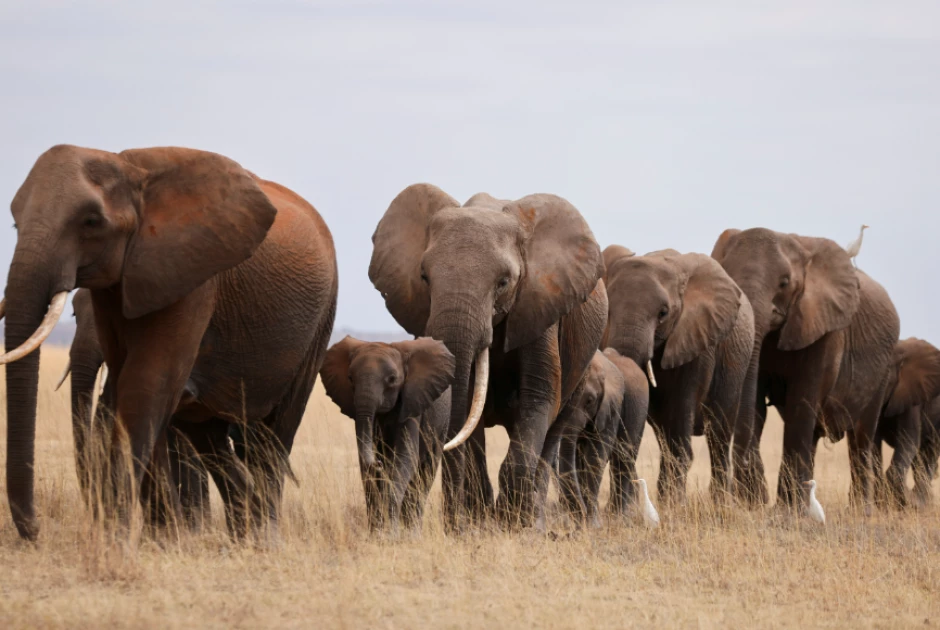Gentle giants: Exploring elephant behaviour and their harmonious coexistence with humans

Elephants walk in the Amboseli National Park, Kenya, August 10, 2021. REUTERS/Baz Ratner/File Photo

Audio By Vocalize
In
the heart of Africa's wild landscapes, a delicate harmony unfolds between two
remarkable species: elephants and humans.
These
colossal creatures, with their intricate behaviours and profound social
structures, share a unique relationship with communities.
As
we celebrate World Elephant Day, with the theme ‘Safeguarding Elephant Habitats
for a Sustainable Tomorrow’ it is imperative to understand elephant behaviour,
shedding light on what allows them to coexist seamlessly with human beings.
The
Enigma of Elephant Behaviour
Elephants,
often described as the gentle giants of the animal kingdom, exhibit behaviours
that echo their emotional intelligence and social complexity.
Within
tightly-knit family units led by matriarchs, elephants nurture strong bonds,
communicate through vocalizations and body language, and display compassion for
one another.
The
strong family bonds within elephant herds prevent straying into human
settlements. Matriarchs guide their families to safe zones, avoiding
interactions with humans and minimizing potential conflicts.
According
to the Chief Executive Officer for ‘Save the Elephants’, Frank Pope, elephants
are incredible survivors and highly adaptable creatures.
“One
of the incredible characteristics of elephants is that they are highly
adaptable creatures. They can survive in a huge range of habitats, from near
desert conditions in places like Mali to high-altitude places like Mount Kenya.
The only thing they are unable to adapt to is poaching due to their high-demand
tusks,” he said.
Elephants
are not solitary wanderers; they are matriarchal species with a deeply
ingrained sense of family and community.
In
the vast landscapes of their habitats, these gentle giants form intricate bonds
that shape their behaviours and interactions. Family groups, led by experienced
matriarchs, create a web of support and protection.
“Elephants
are matriarchal species led by the females. The main groups are female groups
as the centrepiece in their social structure. The females are the matriarchs and
their sisters and offspring,” stated Mr. Pope.
“If
the offspring is male, they will stay in the herd until they become sexually
mature and then the females kick them out and they trail as outcasts and make
their own way and form groups of bachelors.”
Keys
to peaceful coexistence
What
sets elephants apart is their ability to adapt to their environment and coexist
harmoniously with humans. Communities living adjacent to elephant habitats have
developed an unwritten code of conduct that minimizes conflicts. This
understanding includes giving elephants space, not provoking them, and using
natural barriers to safeguard crops.
“The
challenge with coexistence is humans are a very dominant species and push out
into new areas, which pushes the elephants eventually. If we are to coexist we
need to understand what elephants need to survive and understand what human
beings need to survive alongside elephants.
Social
Structure and Communication
Elephants'
intricate social structure and communication systems help them avoid conflicts
with humans. The guidance of experienced matriarchs ensures that herds make
informed decisions, steering them away from areas with potential human
presence.
“We
need to understand how elephants use landscapes, their nutrition and what
barriers exist along areas in which humans have settled. The core of what we
need for harmonious coexistence is empathy for these creatures,” said Mr. Pope.
“We
need to give the people living alongside elephants the tools they need to be
able to coexist peacefully with elephants. We need to help people see elephants
in a different image and help them develop empathy towards these creatures and not
kill and harm them because elephants can be intimidating creatures and conflict
may arise.”
A
Call for Sustainable Balance
Conservationists
and wildlife advocates emphasize the need for responsible development that
takes into account the intricate dynamics of coexistence.
According
to Mr. Pope, elephants move from habitat to habitat, and therefore developing
strategies like elevated railway tracks or wildlife corridors can mitigate the
impact on elephant habitats.
“Where
we need corridors is in places where the ability of elephants to move from
habitat to habitat is threatened. As habitat changes and weather changes
elephants need to move, and if people get in the way conflict may arise,” he
stated.
“Underpasses
and corridors and overpasses can be built as solutions to aid elephants’
movement and minimize the interaction between humans and elephants.”
The
harmonious coexistence of elephants and humans stands as a testament to the
intricate bonds that can form between species. As we marvel at the behaviours
that allow elephants to share their space with us, we are reminded of the vital
role they play in maintaining the balance of ecosystems.
As
development advances, the challenge lies in preserving this dance, ensuring
that the legacy of coexistence continues to be celebrated for generations to
come.


Leave a Comment